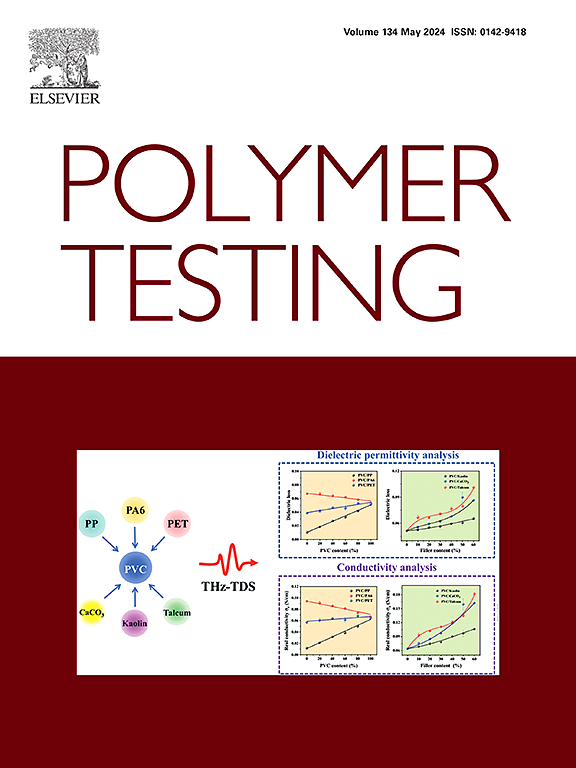多角度拉伸剪切载荷下HTPB推进剂微损伤的实验与仿真研究
IF 5
2区 材料科学
Q1 MATERIALS SCIENCE, CHARACTERIZATION & TESTING
引用次数: 0
摘要
复合固体推进剂的损伤演化受应力状态的影响。为了研究端羟基聚丁二烯(HTPB)推进剂在拉伸剪切条件下的原位损伤演化机理,采用计算机断层扫描(CT)技术对不同角度加载HTPB推进剂的微试样进行了扫描重构。分析了推进剂内部损伤随加载过程的变化规律以及不同代表性体积元尺寸对孔隙率的影响。随后,采用4种RVE尺寸、3种网格尺寸的12种不同有限元模型对松弛载荷进行了数值模拟。实验结果表明:在拉剪加载条件下,孔隙率呈指数增长,具有等效效应,微裂纹收敛形成的宏观裂纹扩展方向趋向于垂直于拉应力分量。当RVE边长达到或超过600 μm时,孔隙率趋于稳定。变角度拉剪加载的数值模拟研究发现,当RVE尺寸为800 μm,网格尺寸为10 μm时,考虑计算精度和效率的计算效果最好。随着加载角的增大,减湿应力先减小后增大,减湿应变呈线性增大趋势。本文章由计算机程序翻译,如有差异,请以英文原文为准。
Experimental and simulation study on micro damage of HTPB propellant under multi angle tensile shear loading
The damage evolution of composite solid propellants is influenced by the stress state. In order to investigate the in-situ damage evolution mechanism of hydroxyl terminated polybutadiene (HTPB) propellant under tensile shear conditions, computer tomography (CT) technology was used to scan and reconstruct micro samples of HTPB propellant loaded at different angles. The variation of propellant internal damage with loading process and the influence of different representative volume element (RVE) sizes on porosity were analyzed. Subsequently, numerical simulations of relaxation loads were conducted using 12 different finite element models with 4 RVE sizes and 3 mesh sizes. The experimental results show that under tension shear loading conditions, the porosity increases exponentially with the equivalent effect, and the propagation direction of macroscopic cracks formed by the convergence of microcracks tends to be perpendicular to the tensile stress component. When the side length of RVE reaches and exceeds 600 μm, the porosity tends to stabilize. The numerical simulation study of variable angle tension shear loading found that when the RVE size is 800 μm and the grid size is 10 μm, the calculation effect considering calculation accuracy and efficiency is the best. As the loading angle increases, the dewetting stress first decreases and then increases, the dewetting strain shows a linear increasing trend.
求助全文
通过发布文献求助,成功后即可免费获取论文全文。
去求助
来源期刊

Polymer Testing
工程技术-材料科学:表征与测试
CiteScore
10.70
自引率
5.90%
发文量
328
审稿时长
44 days
期刊介绍:
Polymer Testing focuses on the testing, analysis and characterization of polymer materials, including both synthetic and natural or biobased polymers. Novel testing methods and the testing of novel polymeric materials in bulk, solution and dispersion is covered. In addition, we welcome the submission of the testing of polymeric materials for a wide range of applications and industrial products as well as nanoscale characterization.
The scope includes but is not limited to the following main topics:
Novel testing methods and Chemical analysis
• mechanical, thermal, electrical, chemical, imaging, spectroscopy, scattering and rheology
Physical properties and behaviour of novel polymer systems
• nanoscale properties, morphology, transport properties
Degradation and recycling of polymeric materials when combined with novel testing or characterization methods
• degradation, biodegradation, ageing and fire retardancy
Modelling and Simulation work will be only considered when it is linked to new or previously published experimental results.
 求助内容:
求助内容: 应助结果提醒方式:
应助结果提醒方式:


